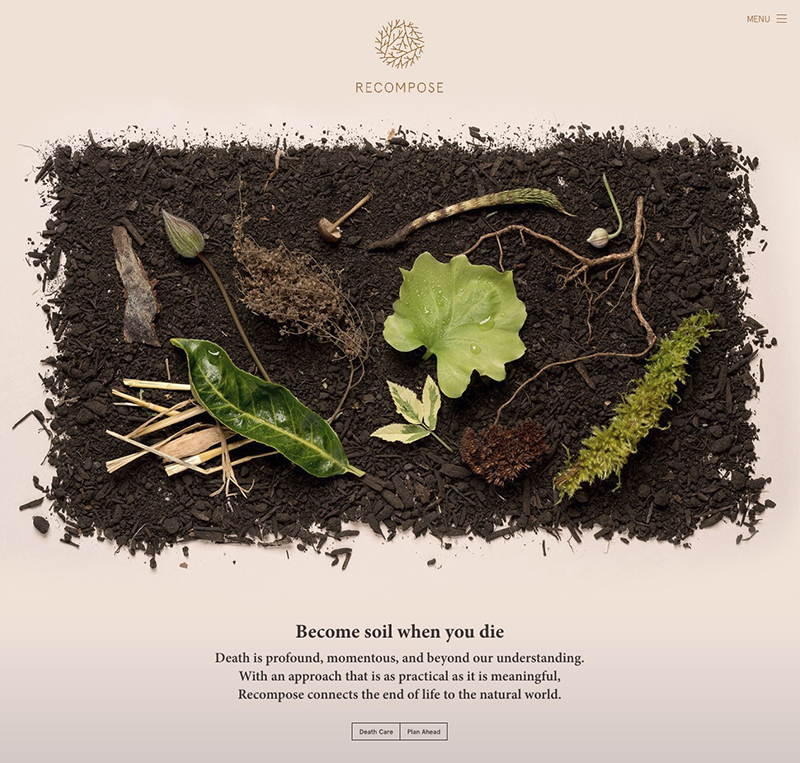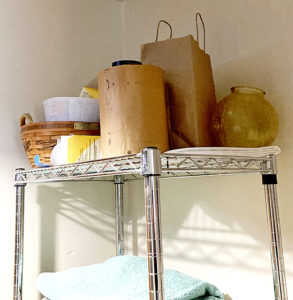Top: Traditional graveyard (left) vs. Bells Mountain forest (right) where human compost finds a final resting home. Images courtesy of Kathleen Cole, CC BY-SA 4.0, via Wikimedia Commons and Recompose
 Sally Brown
Sally Brown
“All we are is dust in the wind” step aside. The first human composting facility, Recompose, opened in Kent, Washington, just south of Seattle, creating an alternative to the classic Kansas song. Now we can turn into compost — the material you can use to control dust in the wind. Talk about finally taking our place in the circular economy. We have arrived.
End of life options used to be pretty limited. You could go the box in the ground route or the can in the closet. Two new options have recently become available. Your newly deceased can be turned into a diamond, and as James Bond can tell you, “Diamonds Are Forever.” Or you can be composted. I, for one, would prefer to make my biggest mark on earth while I’m still breathing. So, for this column, I’ll do a coarse comparison of the environmental impacts of burial, cremation and composting. Diamonds, while they do have a lovely sparkle, can only be made from ashes after cremation which pretty much guarantees that they will be much less planet friendly than finger pretty.
Traditional Burial
First let’s consider the traditional burial plot. That involves a casket and lots of chemicals. It also involves land that is taken out of production. I would consider cemeteries as the human equivalent of landfills. Liquids are removed from the body and replaced with embalming fluids that contain formaldehyde. Formaldehyde has a wide range of uses apart from keeping bodies fresh. It is used to preserve wood and even in cosmetics. A quick search suggests that it breaks down quickly when exposed to sunlight and is also easily degraded in soil systems.
Your body is a different story. According to one article I found, much of the decomposition occurs quickly, within 10 years. However, it takes another 90 for your bones to disintegrate, leaving only teeth, any synthetics you were buried in and some waxy substance formed as your body degrades. Most likely the box and the lovely satin lining will still be around. Most importantly, the plot where you are laid to rest (about 10 feet by 3 feet) is also taken out of commission. Let’s consider the degrading corpse a beneficial soil amendment and the synthetic fibers a small but not significant source of soil contamination. You can even go with a green burial option that eliminates the chemicals, the box and any concrete or metal parts. In other words, the primary cost of burial for this estimate can be the land lost from other beneficial uses.
Now I recognize that in literature and in the movies, many people pay weekly visits to a gravesite to speak with a lost loved one. I will admit, I loved the scene in Harry Potter when he and Hermoine went to visit his parent’s gravesite. Speaking for myself, I have no idea where any of my relatives that went this route are actually buried. I would think that my ignorance is more the norm in this situation than the weekly visits.
Cremation
Next up is cremation. To understand the cost of cremation you have to consider the energy balance of a body. Here I asked Geoff Hill, a professional composter who was very close to taking a job at the newly opened human composting facility in Seattle. Here are Geoff’s estimates for a corpse that we can use for an energy balance: Water content : 65%; Bone weight: 10%. Water content and bone weight can be used to estimate the carbon balance for a 100 kg individual:
100 kg total weight * 0.65 = 65 kg water
100 kg total weight * 0.1 = 10 kg bones
100 kg – 65 kg water – 10 kg bones = 25 kg flesh
That leaves you with 65 kg of water to evaporate and the energy imbedded in 25 kg of flesh to do it. I didn’t even search for the energy in human flesh. That can be left for my zombie counterparts to do. Instead, I looked up the energy in a New York strip steak. Turns out that steak is a good source of calories in addition to protein and iron — 5,000 calories (c) in a kg (2.2 lbs) of meat.
5,000 c in a kg of meat * 25 kg = 175,000 c = 523 kilojoules
25 kg flesh * 5,000 c/kg = 175,000 calories contained in a 100 kg body
Then I converted that to joules (4.184 * calories = 1 g joule) and then to kilojoules (kJ) (divide by 1,000):
175,000 c/body * 4.184 joules per calorie/1,000 joules per kJ = 732 kJ per body
Evaporating the water takes a lot of energy — 4.2 kJ/degree for each kg to make it boil — plus an additional 2,259 kJ/kg to make it transition from water to gas to evaporate that water. Here I am figuring that you’d want to heat that from a cold temperature (to slow decomposition) to boiling or 100°C. You also can’t heat the water without heating up the rest of the body so basically you heat up the whole deal. To reference Shakespeare’s King Lear, unless you can get that pound of flesh without the blood, cremation is an energy intensive process.
Here I am simplifying by assuming that the specific heat (energy required to heat a substance) of the bones and flesh will be the same as the specific heat of the water:
100 kg * 100°C * 4.2 kJ per degree = 42,000 kJ to heat the water, plus
65 kg water * 2,259 kJ/kg = 147,000 kJ to evaporate the water
This totals 189,000 kJ of energy to get rid of the water in a body — or way more energy than that body contains. We can round here and say that cremation requires an additional energy input of 188,000 kJ above the energy contained in the organic solid fraction.
Composting

Facebook thread highlights idea that it may take some time for the general public to warm up to the human composting concept.
Now let’s look at composting as an alternative. Geoff estimates that volatile solids loss during the composting process will be around 50%. He also took a guess and estimated that the C:N ratio of flesh is 7:1. Looking at the protein content of steak (62 g for a 250 g steak) that estimate seems reasonable. Here moisture content is well within the acceptable range for composting particularly if you consider the use of a bulking agent. Recompose, the human composting facility, uses wood chips, alfalfa and straw as bulking agents. Geoff estimates that a 100 kg corpse would yield about:
25 kg flesh * 50% volatile solids loss = 12.5 kg solids
10 kg bones— would likely dissolve but not decompose as bones are made up of calcium and phosphate
The bulking agent will also add to the finished volume, but figuring out how much is just an estimate. How about we guess about another 5.5 kg to end up with a round number? Therefore:
12.5 human solids
10 kg bones
5.5 kg bulking agent
Gives you a total dry weight of 28 kg. Based on the low C:N ratio of a human body and the presence of all of that calcium and phosphorus in bones, you can bet that this will make some nice soil.
Scaling The Calculations
It is always helpful to compare the environmental impacts of different practices on a larger scale to get a real understanding of differences. So instead of just focusing on the differences for one body, I’m going to scale this up to 460,000 bodies, the current toll of COVID-19 in the U.S.
Burial: If all of those bodies were laid to rest in conventional burial plots:
3 m2 (size of conventional plot) * 460,000/10,000 m2/hectare = 138 hectares of land required for burial
Cremation: If instead they were cremated, we can express the energy costs in terms of the annual average electrical use per residential customer (10,650 kWh). As the carbon costs of electricity vary with region, this approach can provide an impact estimate that applies to all regions:
1 kJ = 0.2777 watt hours
188,000 kJ * 0.2777 = 52,208 watt hours per body
52,208/ 1,000 = 52.2 kWh per body
52.2 * 460,000 = 24 million kWh
24,000,000 kWh/10,650 kWh/customer = 2,255 residential electricity customers for a year.
Composting: This calculation is simple:
28 kg of compost per individual * 460,000 individuals /1,000 kg/ ton = 12,880 tons of compost
That is about 10 times as much as you’d need to make a difference on those 138 hectares of land you haven’t taken out of use. Plus, you get to use that electricity for powering homes.
I never much liked the band Kansas and I particularly dislike that song. One of my favorite bands is the little-known Poi Dog Pondering. Poi Dog happens to have a song that I find to be a much preferred alternative to “Dust In The Wind.” “Bury Me Deep” (although with compost a surface application is appropriate) gives us this alternative:
A lifetime of accomplishments of which the dirt knows none,
Only in death can one truly return
Return the carrots, the apples and potatoes,
The chickens, the cows, the fish and tomatoes.
I bet you can guess which is my preferred end of life alternative.
Note: This column is dedicated to my mother, Eleanor Brown, who died this past November.
Sally Brown, BioCycle’s Senior Adviser, is a Research Professor at the University of Washington in the College of the Environment.
















